Sustainability is crucial to building a better world. During Earth Month we’re exploring ways businesses can improve sustainability through electric vehicles and electric vehicle charging.
Electrifying transportation is key to reducing greenhouse gas (GHG) emissions and mitigating the effects of global warming. According to the International Energy Agency (IEA), about 37% of CO2 emissions in 2021 came from the transportation sector. Transitioning to electric vehicles (EVs) can help reduce GHG emissions and avoid climate disaster.
But there are immediate benefits to electrifying your fleet: Switching your fleet to EVs can save you a lot of money in long-term fuel and maintenance costs, give you more control over when and where you fuel or charge up, and even help you operate in more locations across the globe.
EVs eliminate tailpipe emissions and greatly reduce GHG emissions even when they’re charged with power generated with fossil fuel powerplants. EVs are far more efficient than ICE vehicles, which means it takes less energy of any type (even fossil fuel energy) to move them. Higher efficiency means fewer GHG emissions. Additionally, it’s easier to control emissions at a few power plants than it is to control them in millions of vehicles. Lastly, EVs can also easily be powered by renewable energy sources like solar, wind, wave, and geothermal power.
Switching to EVs can also help offset your business’ carbon emissions, reducing tax burdens and helping to avoid any future penalties or fines for carbon emissions.
EVs are inherently less complex than ICE vehicles. According to a recent Forbes article, the typical internal combustion engine (ICE) drivetrain has about 2,000 moving parts while a typical EV’s drivetrain has about 20. And because EVs have fewer moving parts, it’s estimated their drivetrains (motors and transmissions) should last much longer than their ICE counterparts. Many EV drivetrains are engineered to run for up to 500,000 miles without service.
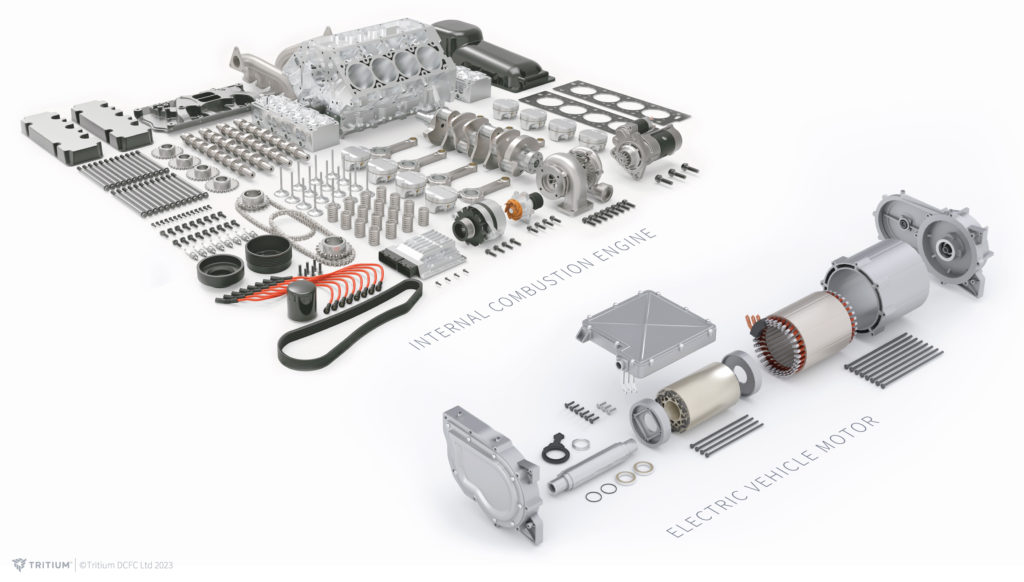
According to a study by the US Office of Energy Efficiency and Renewable Energy, the estimated scheduled maintenance costs for ICE vehicles is approximately 10.1 cents per mile compared to just 6.1 cents per mile for EVs.
According to Consumer Reports, EV drivers pay half as much for repairs and maintenance. Consumer Reports also found that EV drivers can expect to save an average of $4,600 in repairs and maintenance over the life of the vehicle.
More research by the Department of Energy’s Argonne National Laboratory found that EV maintenance costs are 30% lower than ICE vehicles.
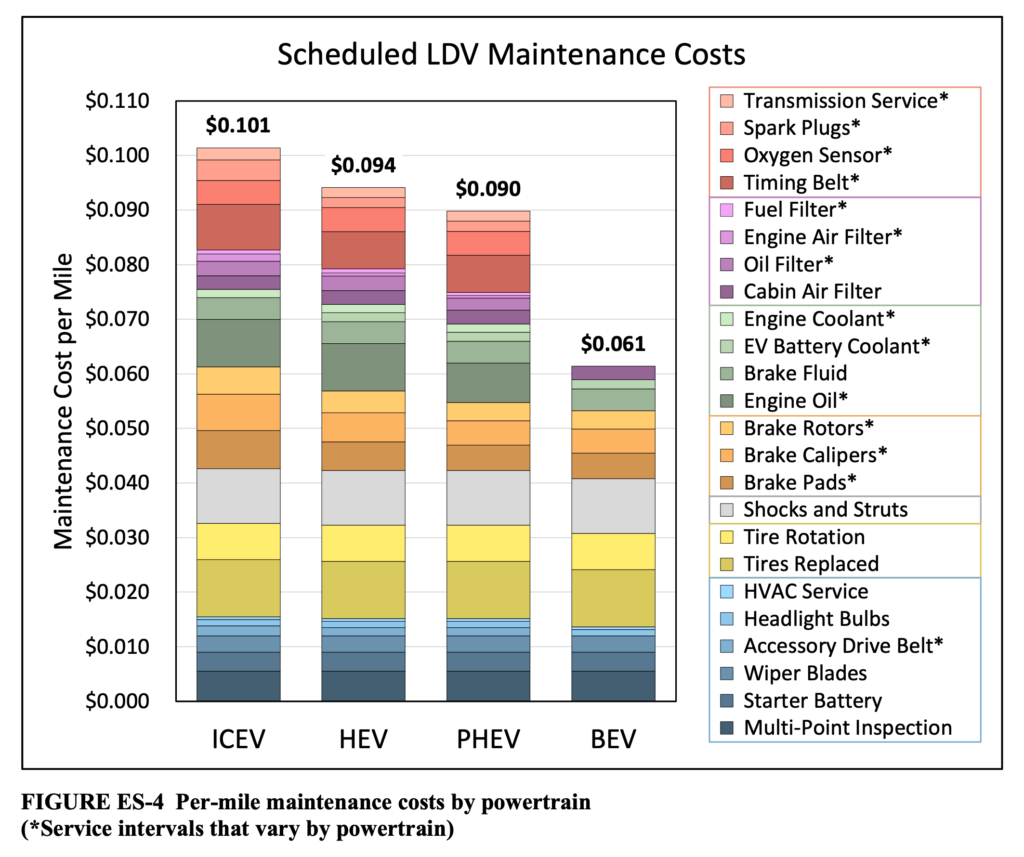
Diesel and gasoline prices fluctuate wildly, but they have steadily rose over time and are subject to large price increases due to conflicts, natural disasters, and political turmoil. These events often have more of an effect on fossil fuel prices than electricity prices. And while electricity prices have risen significantly in Europe, they are still lower than the price of gas or diesel when used for transportation. A recent study by Dutch automotive lease provider Leaseplan found that despite energy price inflation, “fuel costs remain significantly lower for electric cars than petrol and diesel cars: fuel costs represent 15% of the total cost of ownership of an EV, while this is 23% and 28% for petrol and diesel drivers.”
EVs will almost always have lower fuel costs than ICE vehicles because they are more efficient. According to Motortrend Magazine, between 74 and 84 percent of the energy contained in gasoline is lost to heat and friction in an ICE vehicle. If you were to spend €1.80 on a liter of gasoline, only €.36 worth of it is used to move your vehicle. In comparison, only 31-35 percent of the energy in an EV’s batteries is wasted: 10 percent of the source energy from the grid lost in the charging process, 18 percent lost to the drivetrain motor components, up to 4 percent lost to auxiliary components, and another 3 percent lost through powertrain cooling and other vehicle systems.
ICE vehicles rely on networks of fuel stations that may or may not be near your established routes. If you build your own charging network, EVs give you the freedom to charge up when and where you want. Installing EV fast chargers at your offices or distribution centers can:
EVs can charge up overnight and run all day. Amazon plans to deploy a fleet of more than 100,000 EVs for last-mile, in-town deliveries by 2030. The retail giant will use Rivian delivery trucks and trucks from other manufacturers for deliveries across the world. Amazon expects the trucks to run for 12 hours a day and to charge up using DC fast chargers at Amazon distribution centers. The vans are expected to have a 300,000-mile lifespan before major maintenance, greatly reducing total cost of ownership. With these Rivian vans and DC fast charging at its distribution centers, Amazon can eliminate fuel stops and reduce downtime during operating hours.
Many governments around the world are offering financial incentives to make the switch to EVs. Nearly every country in Europe also offers some form of incentive to purchase EVs and EV charging equipment. The European Automobile Manufacturer’s Association (ACEA) has compiled a comprehensive list of EV incentives by European member countries. Many countries are offering thousands to offset the cost of new EVs, and most also offer incentives to purchase EV charging equipment. For example, France is offering up to 40% off the purchase and installation costs of EV charging points for businesses and public entities. There are also many other regional and city incentives available throughout Europe.
In the United Kingdom, the government offers up to £2,500 in incentives for the purchase of a new electric car. Additionally, the UK government has approved £30 million of funding in 2022 to 2023 for fast charging infrastructure, including DC fast chargers. The UK government is authorizing up to £13,000 in grant money per public charge point.
In the US, many states offer tax credits for electric delivery vehicles, and the $1.2 trillion Bipartisan Infrastructure Law includes $5 billion to help states build extensive EV charging infrastructure. There are also many state and regional incentives in the form of tax credits or grants available in the US. You can read more about them in our article here.
In Australia, the Treasury Laws Amendment (Electric Car Discount) Bill provides $2000 off the price of battery-electric and plug-in hybrid vehicles (PHEV). The bill also delivers Fringe Benefits Tax (FBT) exemptions for fleets and novated leases. Australia also raised the Luxury Car Tax threshold for low-emission vehicles to $84,916, from $71,849. The FBT savings amount to about $4700 for an individual.
Our experts can help you plan your fleet’s transition to electric vehicles. Our experts have decades of experience helping logistic companies, public transportation agencies, trucking companies, and rideshare companies integrate EVs and EV fast charging into their business models.
Electric vehicles (EVs) are great for deliveries, maintenance, and other commercial businesses within city limits. They are clean, quiet, and ultra-efficient at lower inner-city speeds. They could also be the only option for running your commercial business downtown as more metros across the globe restrict or ban internal combustion engine (ICE) vehicles in cities. Madrid has already banned ICE vehicles in its downtown and Paris, Athens, and Mexico City have all agreed to ban diesel-powered vehicles by 2025. If you are a building maintenance provider, tradesman, florist, window washer, cleaning company, mobile auto detailer, mobile auto maintenance provider, mobile dog groomer, or any type of small, medium, or large business, you will need EVs to serve customers in many major cities around the world.
Thankfully, many manufacturers are bringing electric vans and commercial vehicles to market, and many have already secured orders from world’s largest retailers and logistics companies and are selling their vehicles to businesses around the world. Here are some new commercial EVs hitting the market in the coming months that could help you make your business more sustainable and prepare you for future legislation or limiting of diesel-powered vehicles.

California-based Mullen Automotive is delivering its I-Go micro delivery vehicle to European cities in 2023. The compact four-door hatchback is perfect for last-mile deliveries in dense European cities. The I-Go is essentially a rebadged Chinese Xiaohu FEV car. It features a 16.5kWh battery pack that is good for 124 miles (200km) on a single charge thanks to the car’s small size and light weight. With a top speed of just 62mph (100kph), the I-Go will not be a great highway vehicle, but with a 34kW motor it will have enough power to compete with urban traffic.
The I-Go meets EU standards and will be available for sale throughout Europe, the UK, Australia, and the US. Mullen has priced the I-Go at just $11,999 (£9900).
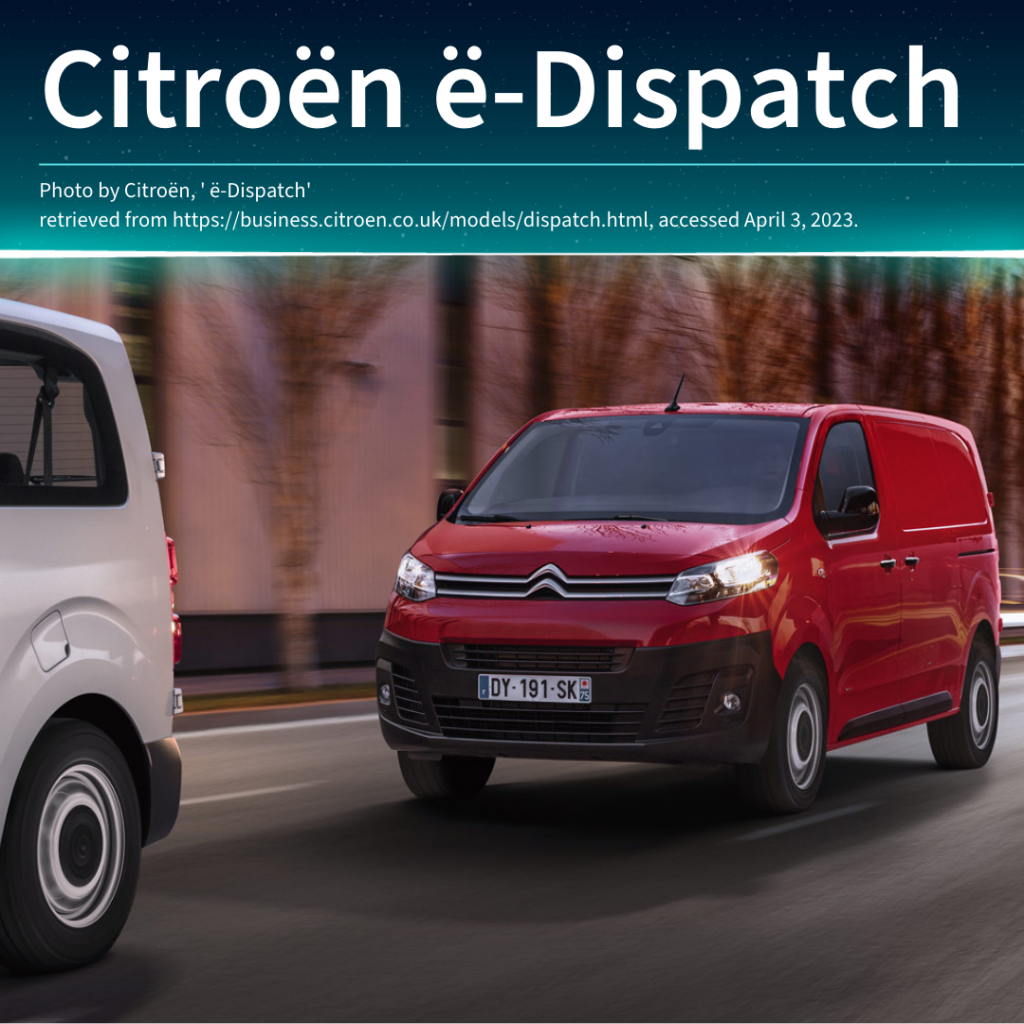
French car maker Citroën has released the ë-Dispatch modular electric cargo van in Europe and the UK. The van can be configured for delivery, maintenance work, carpentry, or any other trade its owners need it for. Accessories include exterior cargo racks, interior shelving, and tow hitches. The van has a range of 196 miles (315km) with a 75kWh battery and can charge up to 100kW, giving it 80 percent charge in about 30 minutes. It can carry up to 1,400kg (3,086 pounds) and has about 6,600 liters (233 cubic feet) of cargo volume. The van has a built-in infotainment system, a spot to hold a tablet, and hands-free sliding doors. The ë-Dispatch has a starting price of about £26,000 in the UK.

California-based Canoo made headlines last year when it announced that retail giant Walmart agreed to purchase 4,500 of its new electric Lifestyle Delivery Vehicle (LDV) electric vans. Several pre-production LDVs were rolled out for testing in Dallas, Texas in 2022 and Canoo plans to deliver production LDVs to Walmart in 2023. Walmart can purchase up to 10,000 LDVs for last-mile deliveries across the US, but the LDV will be available to other businesses too. Canoo has not released official pricing for the LDV, but the company’s consumer Lifestyle Vehicle passenger van is priced at $39,950.
The LDV is equipped with comforts like a tilting, telescoping, heated steering wheel, heated seats and mirrors, automatic wipers, a 10.2-inch touchscreen, and nearfield communication (NFC) smartphone keyless interface. Canoo can also outfit the LDV with interior power outlets, shelves and racks, bin and tote management systems, and roof racks. Last, but not least, Canoo offers custom vinyl wraps for company branding. The Canoo promises to be a great option for small-to-medium businesses looking to electrify their commercial vehicles.
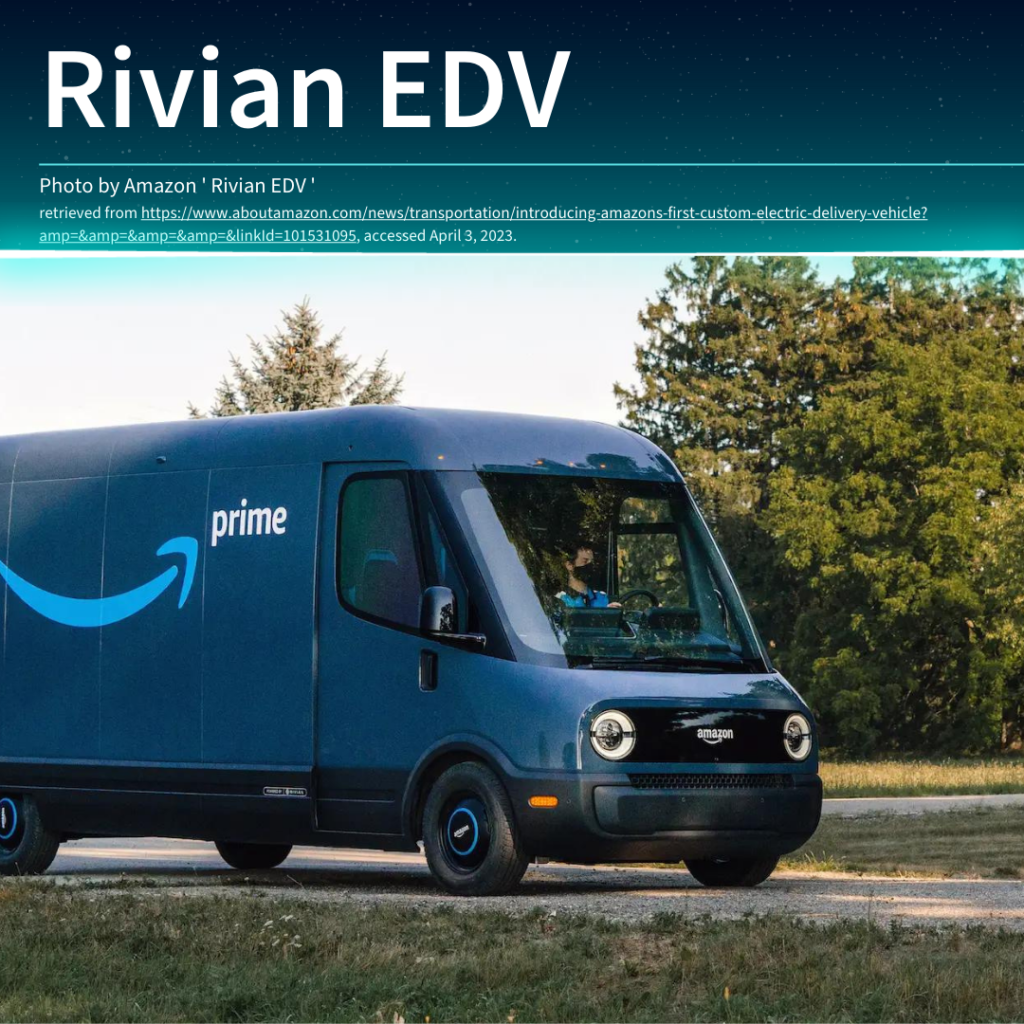
Retail juggernaut Amazon agreed to purchase 100,000 Rivian delivery EVs for use in the US and worldwide. The first 1,000 Rivian Electric Delivery Vans (EDVs) have already been making deliveries around the US. The EDV is offered in three lengths with three different cargo capacities—500, 700, and 900 cubic feet (25,485 liters max). The front-wheel-drive vans have a range of about 150 miles (240km) loaded and can charge at 50kW. It has a heated and air-conditioned driver’s seat and a full infotainment system onboard. The cargo area is outfitted with LED lighting and shelves to store packages. The EDV also uses modular body panels that can be easily replaced if damaged. Rivian has not released pricing for the EDV, but the company plans to start selling them to companies other than Amazon in 2023. The Rivian EDV is larger than the Canoo, but could be a great option for business who need to carry larger cargo or who need more interior space for equipment and power tools.
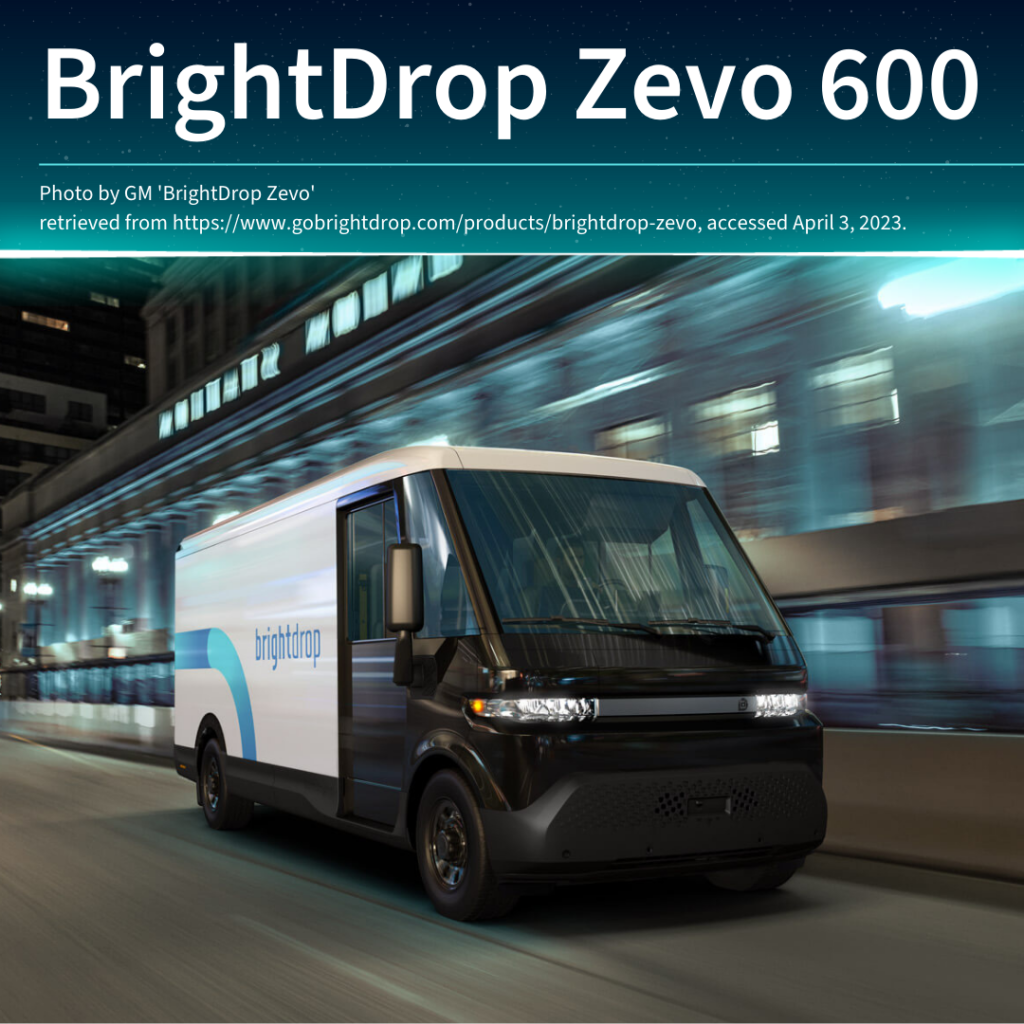
BrightDrop, General Motors’ electric van subsidiary, has sold 2,500 of its electric delivery vans to shipping giant FedEx. The shipping company could purchase up to 10,000 BrightDrop EVs in the future and Walmart has also placed an order. The BrightDrop Zevo 600 can haul up to 2,200 pounds (998kg) and has about 250 miles (402km) of range. The van was designed for utility with low step heights and a configurable area. Pricing info for the Zevo 600 has not been released yet. A smaller Zevo 400 for tight urban environments is also in the works. BrightDrop EVs may be available in Europe in the future, but for now they are only available in the US.
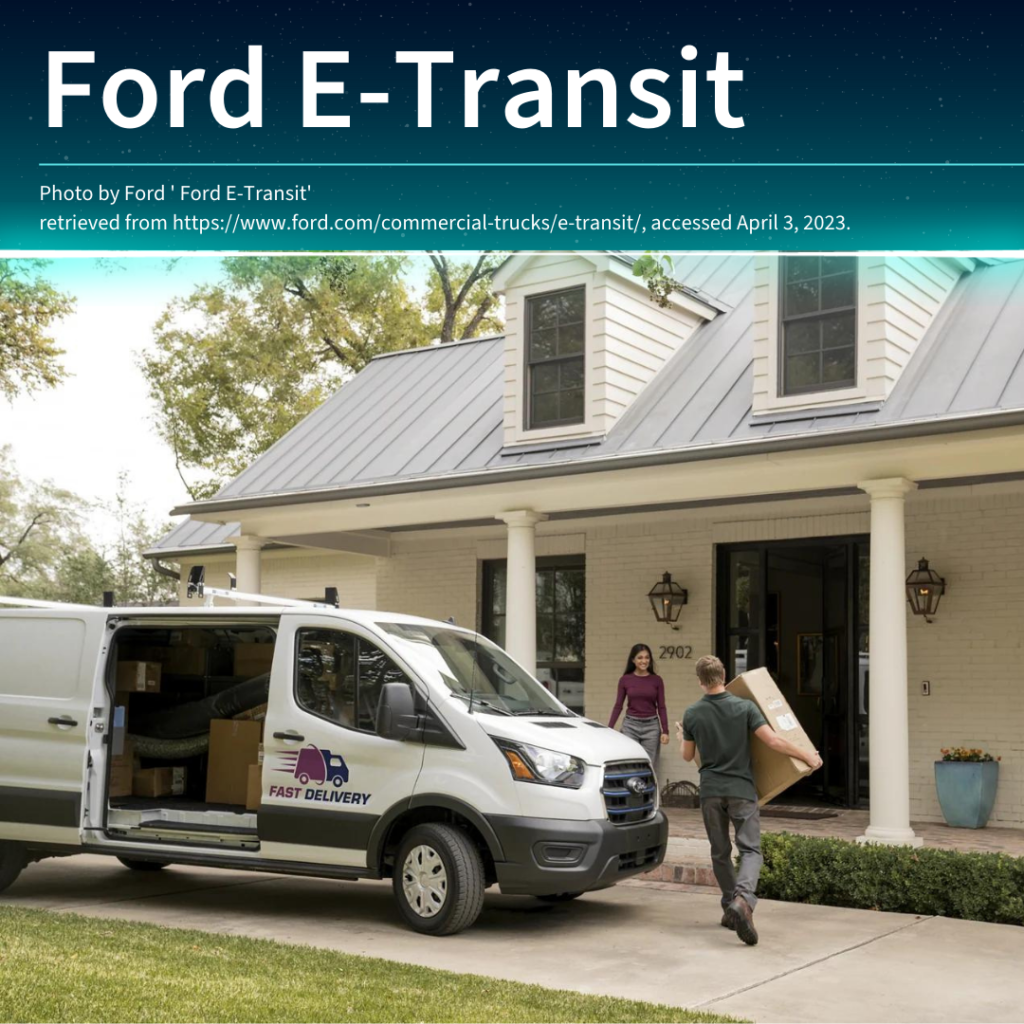
The venerable Ford Transit has gone electric. The E-Transit van is available in three different roof heights, three body lengths, and three configurations. The vans have a range between 108 miles (173km) and 126 miles (202km) and can be equipped with Ford’s 2.4kW Pro Power Onboard power supply that can be used for power tools. It also comes standard with Ford’s SYNC infotainment system and air conditioning. The flexibly utility van starts at $49,575 and can be equipped with a wide variety of gear to make hauling and working easier. It is also available in a variety of colors. The Ford E-Transit is available in the US, Europe, and the UK.
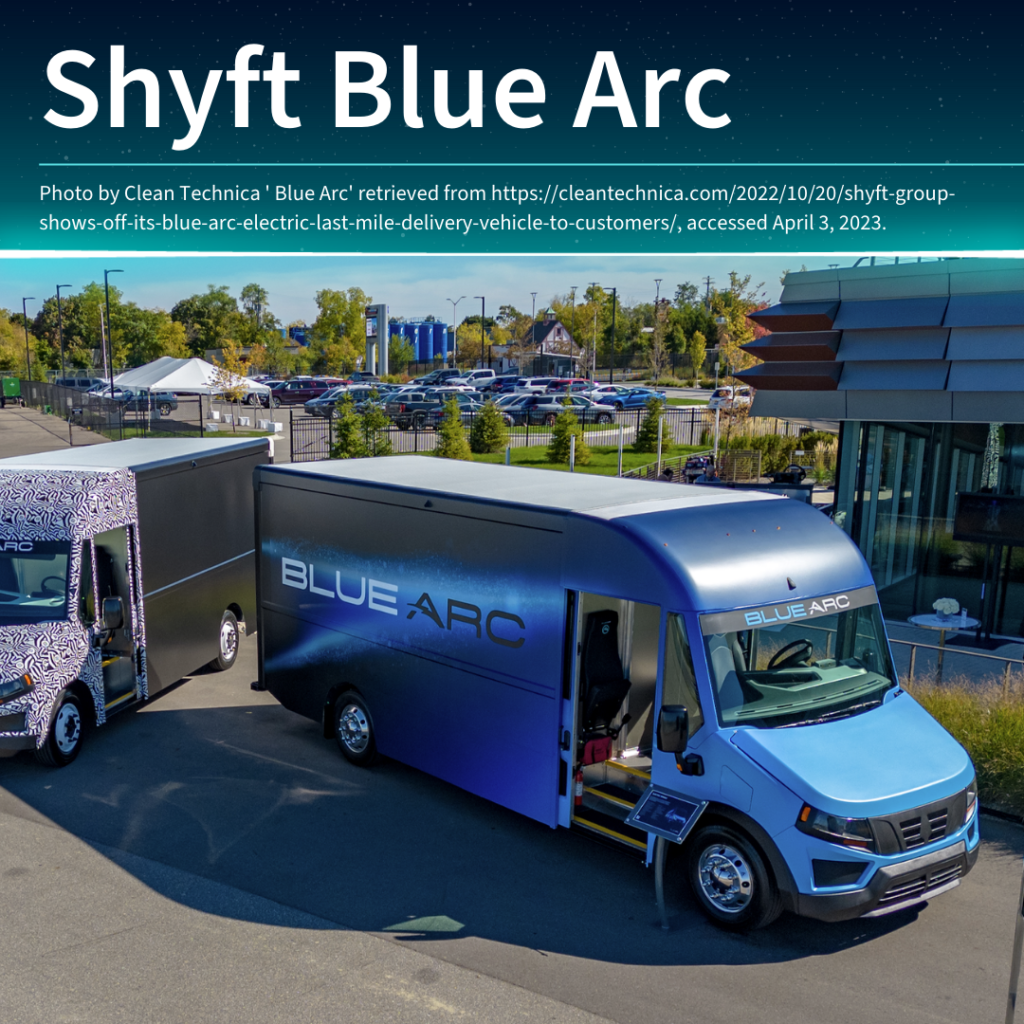
Spartan Motors (now known as the Shyft Group) has built more than half of all Class 3 through 5 square-bodied, riveted walk-in vans on the road in the US. The Michigan-based company oversees truck and truck chassis manufacturers Spartan RV, Utilimaster, Strobes-R-Us, General Truck Body, Royal Truck Body, DuraMag and Magnum, and Blue Arc. Blue Arc is the company’s foray into electric delivery vehicles and their first EV is a modular, configurable Class 3 to 6 delivery van (12-16-foot length options). The van uses a new motor/differential from well-known driveline manufacturer Dana. In traditional rear wheel drive drivelines, power is sent from the engine or motor do the rear wheels via a driveshaft. Dana has mounted the motor directly on the rear differential, negating the need for a driveshaft.
The Blue Arc can be outfitted with two 164-240kWh battery packs good for about 150 miles of range when loaded to 50-percent capacity. The Blue Arch motor and battery runs on 800-volt architecture, meaning it can charge up its batteries in just two hours. For now, Blue Arc electric vans are only available in the US, but they could be a great option for businesses that need extra cargo and hauling capacity for large-scale jobs.
If you want to learn more about how to electrify your fleet, contact one of our experts today.
Sustainability is crucial to building a better world. During Earth Month we’ll explore ways businesses can improve sustainability through electric vehicles and electric vehicle charging.
We know that electric vehicles (EVs) can help reduce greenhouse gas emissions, but how sustainable is EV charging? Short answer: More than filling up a gas tank, regardless of the power source.
According to Climate Watch, ground transportation is responsible for 11.9 percent of global greenhouse gas emissions. Those emissions are the result of directly burning gas and diesel fuel in internal combustion engines (ICEs). Reducing or eliminating greenhouse gas emissions from ground transportation is crucial to reducing the effects of climate change. The Intergovernmental Panel on Climate Change (IPCC) estimates that humanity needs to keep global warming to under 2° C by the year 2100 to avoid catastrophe. Swapping our ICE vehicles for EVs will help us hit that target. However, there’s a catch.
More than 63 percent of our electricity worldwide is generated using fossil fuels. Surprisingly, switching to EVs without switching to low-carbon energy sources will still help reduce emissions. EVs eliminate tailpipe emissions and reduce greenhouse gas emissions even when they’re charged with power generated with fossil fuel powerplants. That’s because EVs are far more efficient than ICE-powered vehicles.
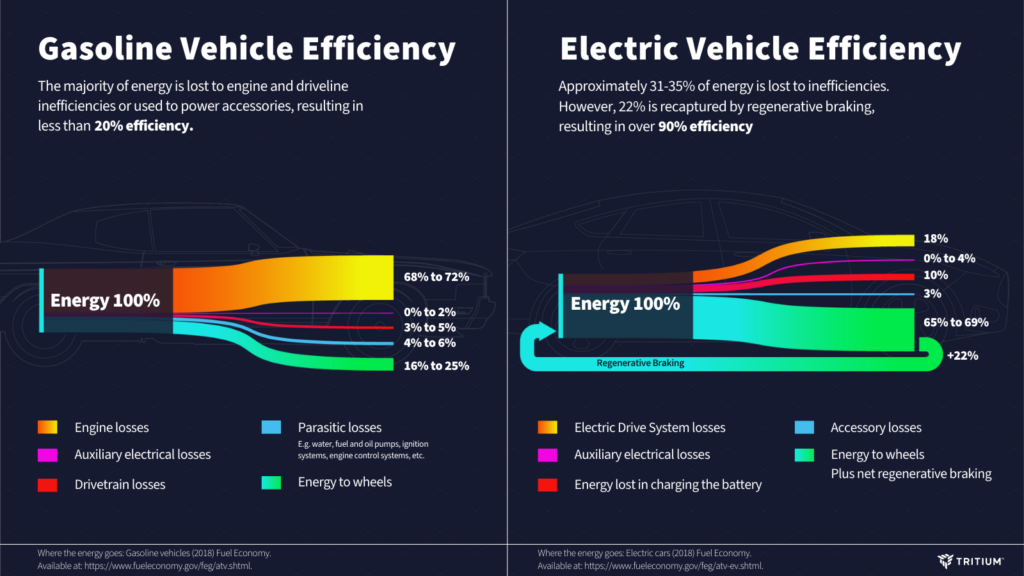
Motortrend Magazine found that between 74 and 84 percent of the energy contained in gasoline is lost to heat and friction in an ICE vehicle. If you were to spend €1.80 on a liter of gasoline, only €.36 worth of it is used to move your vehicle. In comparison, only 31-35 percent of the energy in an EV’s batteries isn’t used to push the car down the road.
EVs can be charged using power from renewable energy sources like solar, wind, geothermal, nuclear, hydro, and tidal. Currently only 36 percent of global energy comes from low-carbon sources, but that figure is growing daily. The International Energy Agency (IEA) estimates that global renewable power capacity will grow by 2400 gigawatts (GW) between 2022 and 2027—that’s about the current total power output of China. The estimate is 30 percent greater than the group’s predictions in 2021 and the IEA estimates that renewable energy sources will account for more than 90% of global electricity expansion during the next five years. According to the IEA, the world is set to add as much renewable power in the next 5 years as it did in the past 20. And powering EVs with renewable energy will drastically reduce atmospheric greenhouse gas emissions.will drastically reduce atmospheric greenhouse gas emissions.
Manufacturing has to be considered when assessing the sustainability of any technology. EVs store energy in batteries, which are complex and energy intensive to manufacture. Do those complex, mineral-rich batteries make EVs and EV charging unsustainable when compared to their ICE counterparts? No, even when considering the energy and materials needed to make lithium-ion batteries, EVs are still more sustainable than ICE vehicles.
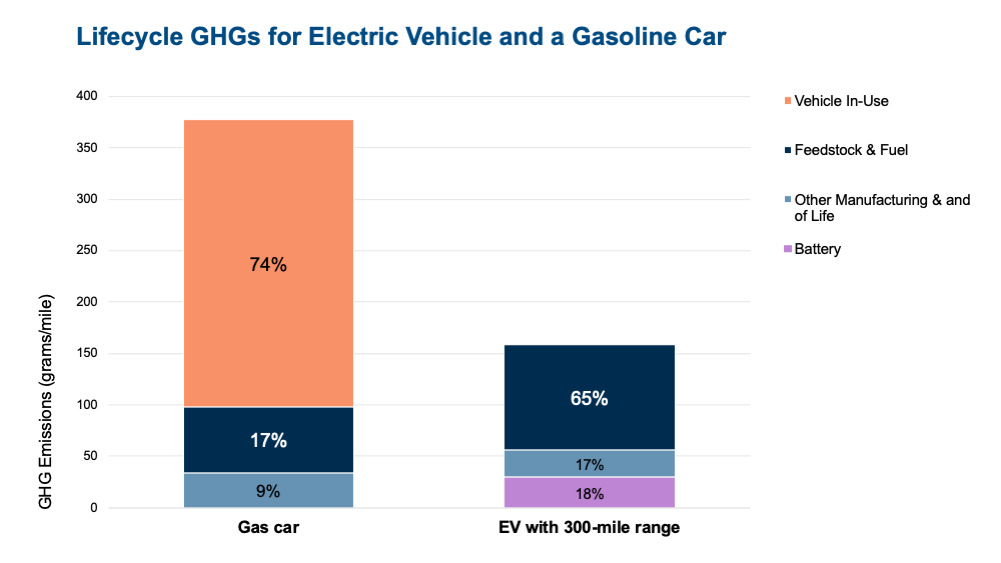
Researchers at Argonne National Laboratory recently conducted a study to estimate total lifetime greenhouse gas emission for both a gasoline car and an EV with a 300-mile electric range. They found that the emissions associated with building EVs are slightly higher than they are for ICE vehicles, but lifetime emissions are less than half.
The lower lifetime greenhouse gas emissions are the result of greater EV efficiency and the greater estimated overall lifespan of EVs. EVs are less complex than ICE vehicles. The typical internal-combustion engine (ICE) drivetrain has about 2,000 moving parts while a typical EV’s drivetrain has about 20. Because of that, it’s estimated EV drivetrains (motors and transmissions) should last longer than their ICE counterparts. Many EV drivetrains are engineered to run for up to 500,000 miles without service. That far exceeds the typical ICE drivetrain lifespan of about 133,000 miles.
EVs (and EV charging) are better for the environment and humanity than ICE-powered vehicles. When powered by renewable energy, they become the most sustainable form of powered transportation we’ve created. EVs and their charging infrastructure are crucial to our future. And governments around the world are investing heavily in EVs and EV charging infrastructure. The United States federal government is providing more than $5 billion in funding and incentives to build a coast-to-coast fast charging network and the European Union has dedicated $270 billion to its own green new deal to invest in renewable energy and other sustainability projects, including EV charging. EVs and EV charging infrastructure are here to stay for the long term and they’ll help humanity reduce greenhouse gas emissions and avoid catastrophic climate change.
Contact us today to consult an expert about how to get started with EV charging for your business.
Finding space for EV charging infrastructure in Ireland’s dense and compact cities, towns, and villages can be a challenge. Street parking is limited and many residents don’t have access to car parks outfitted with direct current (DC) electric vehicle (EV) fast chargers. EasyGo, has teamed up with Ireland’s leading telecommunications company, eir, to find a solution. eir is working with EasyGo to convert hundreds of former telephone booth locations to DC fast charging locations. EasyGo chose Tritium’s 50-75kW all-in-one, modular DC fast chargers to get the job done and serve the needs of drivers.
EasyGo is the largest private car charging network operating in Ireland. It hosts and operates more than 3,000 chargers throughout the country and has more than 35,000 subscribers. The company was founded in 2018 and is headquartered in Maynooth, Kildare. EasyGo’s mission is to provide EV drivers with the network they need to make sustainable transport a reality. EasyGo has approximately 30 employees and offices in Belfast and Cork. EasyGo are supported by Rubicon, one of the world’s leading investment banking firms focused solely on the infrastructure, energy, and utilities sectors.
According to the Society of the Irish Motor Industry (SIMI), about 1 out of every 7 cars sold in Ireland in 2022 were fully electric. Ireland needs a network of fast chargers to keep up with growing demand. Additionally, transport accounts for one-third of Ireland’s energy-related CO2 emissions so increasing adoption of EVs is a key aspect in Ireland’s Climate Action Plan.
Ireland’s eir phone booth locations are great for building that network, but they were never meant to have a large footprint. When EasyGo was tasked with converting the spaces into EV charging sites, they needed an all-in-one charger with a compact footprint that could be easily installed in the same space as a typical phone booth. The chargers would also need to provide reliable, fast charging capable of recharging an EV in a matter of minutes to maximize charger usage.
EasyGo chose Tritium’s RTM compact and modular 50-75kW DC fast chargers. Two RTM chargers can easily fit in the space formerly occupied by a single phone booth. The charger is sealed against the elements (IP65 rated), is liquid cooled, and is modular which means it can be easily upgraded, maintained, and serviced. “The RTM is the perfect solution for tight spaces like the former eir phone booth plots,” said Chris Kelly, Founder and Technical Director of EasyGo. “And its modular design lets us configure it based on site power availability—some sites can handle 75kW chargers, others 50kW. The RTM gives us the flexibility to spec the right charger for the location.”
EasyGo ordered more than 200 Tritium RTM chargers to install at sites around Ireland. The chargers will be configured to deliver 50kW or 75kW based on site power availability.
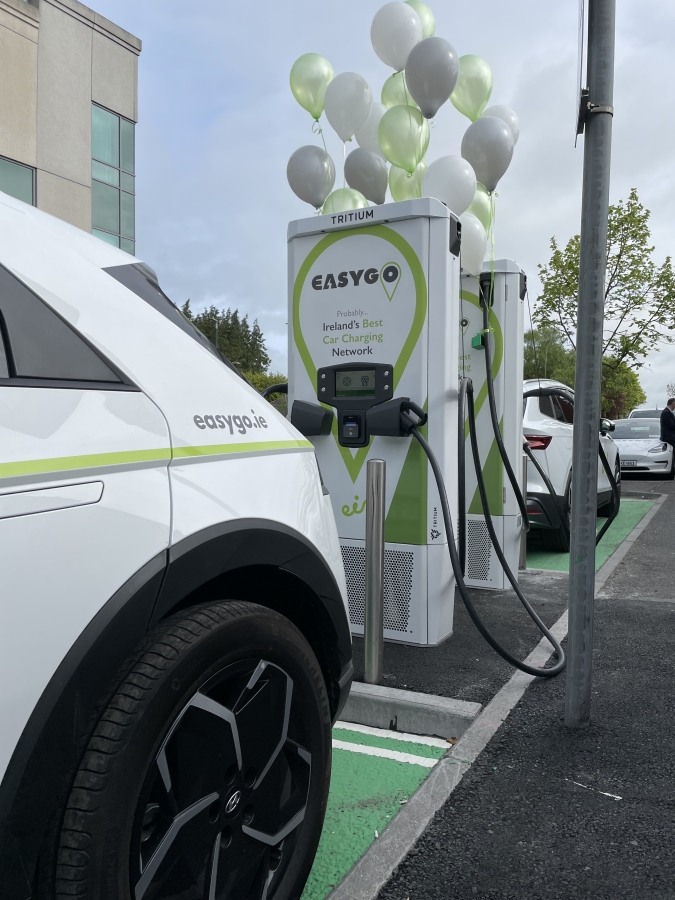
EasyGo and eir launched their new program in May 2022 and installed Tritium chargers at 70 locations in the counties of Offaly, Mayo, Cavan, Waterford, Kilkenny, and Tipperary. EasyGo are actively engaged with other local authorities to identify 120 additional locations across Ireland to install new Tritium DC fast chargers, and this program will be delivered at zero cost to county councils.
“Electric vehicles are a critical part of the Government’s Climate Action Plan which sets out a target of almost one million electric vehicles on the road by 2030,” said eir CEO Oliver Loomes. “We are proud to partner with EasyGo and each of these county councils to assist in the installation of EV charging points across the country. This new infrastructure will benefit the community the way the public payphone service once did. Today, EasyGo and eir are in discussion with county councils across the country, and we hope others will follow this lead. By replacing unused infrastructure with fast EV charging, we are helping to make the transition to electric vehicle ownership a viable alternative for people across Ireland.”
Tritium’s stand-alone RTM75 50kW-75kW DC fast charger is perfect for retail environments or anywhere a compact, all-in-one charger is required.
During the past few years, the global electric vehicle (EV) industry has experienced tremendous growth. According to Bloomberg New Energy Finance, total global electric vehicle sales went from approximately 3.2 million in 2020 to 10.3 million in 2022. The firm predicts more than 13 million EV sales in 2023 and exponential growth in the coming years—as many as 20 million EV sales in 2025. Global sales of commercial EVs also more than doubled in 2021 and Bloomberg reports that large global truck makers expect 35 to 60 percent of their annual sales to be electric trucks by 2025.
EV charging infrastructure is growing as well. According to the International Energy Agency (IEA), there were nearly 1.8 million public charging points worldwide in 2021. Nearly 500k chargers were installed globally just in that same year. According to the IEA, the average annual fast charger deployment growth rate in 2021 was 48 percent. BloombergNEF estimates that between now and 2040 the growing global EV fleet will require between 340 and 490 million chargers to stay on the road. The firm also predicts that the cumulative global investment in global charging infrastructure will exceed $1 trillion between today and 2040. They estimate that fast chargers will deliver 50 percent of EV energy demand and will account for 60% of total charging investment.
There is undoubtedly a huge push to build global DC fast charging networks. The US government is providing more than $5 billion in funding and incentives to build a coast-to-coast fast charging network, and many countries in Europe are rolling out similar programs to spur EV charging infrastructure growth. 2023 will be a big year for EVs and EV charging, but there’s more to the story. In this article we’ll explore some trends and predictions for the EV and EV charging industry in 2023 and beyond.
On February 15, 2023, the Federal Highway Administration (FHWA) and the Biden Administration announced standards for chargers purchased and installed with NEVI funding. These include:
Chargers used in NEVI projects must also meet Buy America standards:
Tritium will soon announce the company’s NEVI solution, which is expected to meet all the requirements outlined by the FHWA and the Biden Administration, and will be built in our new Tennessee facility.
NEVI is accelerating EV charging infrastructure rollout in the US, but we’re just at the beginning of the exponential growth curve. Many states are just getting started with their NEVI programs and most won’t be ready to install chargers until later in 2023. We predict that NEVI chargers will start to be deployed en masse in 2024.
Norway proudly proclaims that it’s the EV capital of the world—for good reason. In 2022, 73% of new cars sold in Norway were EVs and the country plans to transition its entire fleet to EVs by 2025. The country is fueling the transition with a combination of incentives and taxes on fossil-fuel-powered vehicles.
Norway is expanding its DC fast charging network to keep up with its growing EV fleet. The country of 5.3 million people has more than 18k public charging stations total and more than 5k DC fast charging stations. That gives the country one of the highest ratios of EVs to charging stations in the world. Demand for DC fast chargers remains steady in Norway, and the country is installing the fastest-available chargers along highway corridors to facilitate longer trips with EVs and electric trucks. We anticipate that Norway will continue to build out its charging networks, upgrading low-speed chargers with high-speed DC fast chargers in 2023.
Germany also saw rapid growth in EV charging infrastructure in 2022. The number of public charging stations grew from around 25k to 30k over the course of the year. Most of those were DC fast charging stations. Germany has approximately 13,192 kilometres (8,197 mi) of Autobahn (highways), where DC fast charging is key to crossing the country in short timeframes. German automakers have been at the forefront of fast charging, producing some of the fastest-charging cars in the world. Volkswagen (VW), the world’s largest automaker in 2022, released a series of EVs under its brands VW and Audi in 2022 capable of DC fast charging. The flagship Audi e-tron GT is capable of charging at a maximum rate of 270kW and most VW EVs charge at a maximum 120kW rate. DC fast chargers will be key for German EV owners and many charging stations in Germany have already upgraded to ultra-fast 350kW-plus DC chargers.
Both countries will also be deploying more heavy freight electric trucks, which have large-capacity battery packs and can especially benefit from 350kW-plus charging. We anticipate Germany and Norway leading the charge to 350kW DC fast chargers in 2023.
In 2022 many companies began electrifying their fleets. Walmart purchased 4,500 Canoo Electric Delivery Vehicles (EDVs) and reserved 5k GM BrightDrop electric vans for last-mile deliveries. The company also trialed Freightliner eCascadia and Nikola heavy electric trucks for larger deliveries. Amazon also recently rolled out a fleet of Rivian electric trucks to 100 cities across the US and plans to eventually deploy 100,000 electric trucks for deliveries. The United States Post Office is also going electric, promising to spend nearly $10 billion on a fleet of more than 60k EVs by 2028.
In Europe, Amazon is also planning to spend €1 billion to electrify its delivery fleet. Many other companies are already switching to electric delivery vehicles to reduce noise and air pollution in cities. In early 2023, Germany opened up its first electric truck corridor designed specifically for heavy freight vehicles. The 600-km (373-mile) stretch of the Rhine-Alpine corridor across Germany has six charging locations that feature ultra-fast 300kW charging specifically for heavy trucks. Swedish truck maker Volvo also started delivering their heavy freight EV, the VNR electric, across the world. The truck gets a range of 440km (275 miles) from its massive 565kWh battery and is capable of easily hauling heavy loads long distances.
Many rideshare fleets are also going electric or partially electric. US-based rideshare company Revel is fully electric and in Europe Uber has teamed up with Hertz to make 25k EVs available to rideshare drivers. Uber also says that nearly 50k drivers in the US have rented a Tesla through the program and have completed more that 24 million fully electric trips. Uber plans all of its trips to be “zero emissions” under its Green Program by the end of the decade. US rideshare company Lyft has also vowed to go 100% electric by 2030.
Tritium has received orders for DC fast chargers from fleet operators around the globe and we anticipate more fleets will continue to transition to electric in 2023.
Many EVs have relied on 400v battery architecture, but the future is 800v and beyond. Twice the voltage means significantly faster charging times for EVs. The Audi e-tron GT and Porsche Taycan, Lucid Air, Hyundai IONIQ 5 + 6, and Kia EV6 already use 800v architecture and they are capable of gaining about 200 miles of range in under 20 minutes. 800v battery systems can also be smaller than 400v systems. We believe that more auto manufacturers will make the move to 800v architectures in 2023 and beyond. Toyota/Lexus is already working on 800v systems and much of the industry is expected to shift to 800v systems by 2025. These faster-charging EVs can take full advantage of ultrafast 350kW+ chargers currently on the market or in development. Tritium is currently planning to release a 400kW charger in the near future to meet the needs of ultrafast charging EVs.
But not every EV needs to charge at blistering speeds. Many commercial and fleet EVs can charge up over an hour-long lunch break or slowly overnight. That means commercial EV fleet owners can be better served by multiple, smaller DC fast chargers. DC wall box chargers offer high-speed charging in a compact, affordable, and scalable package. Tritium is currently developing a DC fast charging wall box for our PKM system. These compact chargers will connect to our PKM power rectification units and provide DC fast charging at scale for commercial fleet EVs. We expect the market for wall box DC fast chargers to grow in pace with the growth of commercial fleet EVs.
Alternating current (AC) chargers were cheap and convenient in the early days of EV infrastructure. But they’re slow, capable of delivering a maximum power of just 22kW. Many public AC charging points are being replaced with DC chargers to improve turnaround. Even lower-power DC fast chargers (50kW) can charge EVs in half the time of the best AC chargers. DC chargers are becoming the standard for public charging. According to the IEA, the rate of DC charger adoption has grown faster than the rate for AC charger installations between 2015 and 2021.
In 2020, Europe installed far more DC fast chargers than AC chargers and in 2021 the number of fast charger installations were up 30% to about 50k units. The United States also saw rapid growth in DC fast charger installations during the same time. More than 15k DC fast chargers were installed in Korea in 2021, 50% more than 2020.
Tritium expects to see continued growth in DC fast charging, and slowing growth for AC charging. We still see a role for AC charging at home where one or two cars can charge overnight, but many public AC chargers simply won’t be feasible for many charge point operators or businesses.
The EV charging market is growing fast. It helps to have experts by your side who can keep up with the changes and developments in EV charging. Our experts monitor and analyze the EV charging industry, its developments and regulations, and the latest trends and developments. Contact us today to learn how EV charging could help your business be more sustainable, efficient, and profitable.
According to a BNEF report, humanity will need approximately 290 million more electric vehicle (EV) charging points by 2040 to keep up with the growing global EV fleet. Many of those charge points will generate revenue for owners and improve business where they’re installed—EV drivers often shop and snack while their cars charge up.
Whether you’re in real estate, hospitality, retail, or food service, you’re probably thinking about EV chargers. Installing and maintaining them, however, can be expensive and complicated. Thankfully, there are ways to reduce total cost of ownership (TCO) for high-speed EV charging points.
This article outlines the fundamentals of deploying an EV charge point and ways you can save money throughout the process. It covers:
Later we’ll dive deeper into ways to build and deploy charging systems, exploring technical details, regulatory issues, and cost-saving strategies.
You might be tempted to rush into installing a charger in your business’ parking lot or your apartment building’s parking garage, but there are many things to think about before you break ground.
The Tritium team can help you research your site before you make a purchase. We have experts around the world who know local regulations, have relationships with utility companies, and can even help estimate traffic in and around your charge site. Contact us to schedule a consultation.
After site planning, you’ll need to choose your charging hardware. You may be tempted to purchase the most affordable charger, but entry level chargers can end up costing you more over time. That cheap charger may not be able to handle tomorrow’s EVs or present more issues, and you’ll be upgrading before you know it.
When shopping for chargers, look for modularity, scalability, and upgradability. Even if you’re starting small, choose a charger or chargers that can grow to meet future demand. Tritium’s RTM and PKM lines of chargers can be upgraded over time to deliver more power to more EVs, which means you can start small and develop your charging site over time.
Tritium PKM chargers can also share charging infrastructure. DC fast chargers need high-power electronics to turn the alternating current (AC) from the power grid into direct current (DC). This equipment is housed in a power cabinet, and most DC fast chargers need dedicated power cabinets to run. A PKM charger can share a single power cabinet with up to three other PKM chargers, reducing the overall cost of the charging system and making it easier to expand your charge point when you need to.
Chargers should also be able to weather the elements. Look for chargers that are sealed and rated for rain, wind, and dust. All Tritium charging stations are IP65 rated, meaning they meet strict standards for water and dust resistance.
Additionally, electric vehicles use a variety of connectors. Pioneering EVs like the Nissan Leaf used CHAdeMo (“CHArge de MOve” which Japanese EV organizations translate as “charge for moving”). Now most EVs use Combined Charging Standard (CCS1 or CCS2) connectors. Europe has standardized CCS2 charge connectors, while the US uses CCS1.
Also look for modern features like Plug and Charge integration, a communication protocol that lets drivers simply plug their EVs in for a charge without having to enter billing information—billing info is stored in the car itself. Standard payment processing should also be available for vehicles without Plug and Charge capabilities.
There’s a lot to learn about DC charger technology before you make a purchase. Working with an expert can make the process much easier and safer.
There are many government, energy company, and non-profit incentives for EV charging infrastructure, ranging from tax credits to rebates to grants. These programs were created to speed up the transition from internal combustion cars to EVs and to help EV owners who might not have access to a charger at home.
And there are many programs and incentives like this across the globe.
These are just a few of the countries and groups that are helping to meet government targets to phase out internal combustion cars and build out EV charging infrastructure. The best way to find incentives in your area is to talk to an expert. At Tritium we can help you find EV charger incentives for your region.
Most people think of EV chargers as appliances—you plug them in and they just work. But DC fast chargers handle a tremendous amount of power and generate a lot of heat. Over many charges, components can be at risk of failure and will need to be replaced. Chargers will need regular scheduled maintenance just like any other machine. Keep this in mind when choosing your equipment. Is it easy to repair? Can repairs be done in the field? Maintenance costs can add up over time and it pays to choose a charger that is designed to be easily maintained.
Fast chargers also run complicated software that interfaces with multiple networks, including utilities networks, payment processing networks, and charging point operator networks. That software requires updates and maintenance just like your PC. What kind of software support does the manufacturer offer? Think long term. Tritium software not only handles car charging, but also works with payment processing and utilities networks. We have dedicated software engineers who work to keep up with the latest developments in EVs, battery tech, and networks.
There is a wide range of positive economic and environmental aspects of the expected growth in the deployment of EV charging infrastructure worldwide. As the world shifts towards electrification, there are many options and programs available to assist operators with cost-effective deployments of DC fast-charging solutions. Choosing a qualified partner can be the best way to ensure you get the ultimate return on your investment.
Electric vehicles (EVs) don’t all charge at the same rate. Some charge faster than others, and all of them charge at different rates over time. Even the fastest-charging passenger vehicles like the Audi e-tron GT do not draw their rated 270kW the entire time they’re plugged in to a DC fast charger. (Note: Large commercial vehicles like delivery trucks and buses can draw full power for most of the charging cycle.) That means you don’t need to deliver maximum power to every charger on your site at the same time. The chargers on your site can be networked and use load balancing to ensure EVs get the power they need when they need it—and you won’t have to outfit your charging site with gigawatts of power.
Charging a lithium-ion battery takes finesse—charge them too quickly or too much and they could overheat and become damaged. To prevent this, EVs use software to control the power delivery to the battery. Initially they can accept high levels of power, but as the battery charges up, charging levels drop to maintain battery health. Load balancing takes advantage of this difference in charging rates over time to deliver the right amount of power to EVs when it’s needed.
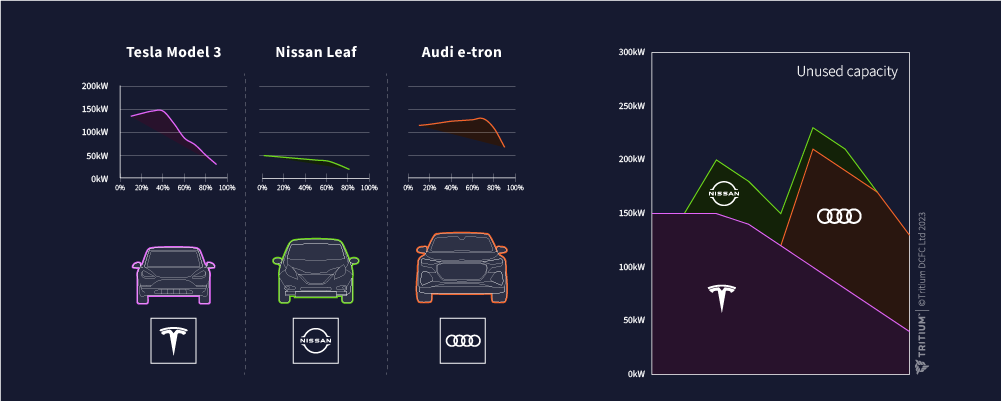
Load balancing lets you build a charging site now that meets the needs of EV drivers and your budget. You can build a site with multiple high-output DC fast chargers without the need to supply it with enough power to run all chargers at maximum power at the same time. This is crucial: You’ll save on utility-side infrastructure costs and you can upgrade site power when needed. This also expands the number of potential sites for your charging stations. Some sites may not have enough utility power now but will in the future. Load balancing lets you build a site now with a full complement of DC fast chargers and add more power capacity over time to meet future EV demands.
Tritium PKM150 chargers leverage the diversity of electric vehicle charging speeds via an innovative DC microgrid architecture and a proprietary algorithm to send the right amount of power to each charging station as required. The algorithm monitors various parameters, including available grid power, each vehicle’s requested power, and any active OCPP smart charging profiles, and dynamically shares power between all connected charging stations. Thanks to this load-balancing software and system design, four PKM150 chargers can share power from a single rectifier unit without the need for external load management solutions. This saves infrastructure and installation costs at the site.
Electric trucks and vans are quiet, reliable, and clean. They make our cities quieter, cleaner, and healthier. That’s why US federal, state, and even city governments have created multiple incentive programs for businesses to make the switch. Many states offer tax credits for electric delivery vehicles, and the $1.2 trillion Bipartisan Infrastructure Law includes $5 billion to help states build extensive EV charging infrastructure. Whether you’re a business or state or local government agency, now is the perfect time to take advantage of incentives to build your electric fleet—and you can rest assured that the public charging infrastructure will be there to support it.
Before you electrify your fleet, you’ll need a plan to determine what kind of charging infrastructure you need.
First, start with site design. Every business will have different vehicles, site configurations, drivers, and needs. Ask the following questions:
These questions and others will form a brief to help you truly understand what your goals are.
Once you’ve determined your site design, look at charging hardware. With a good understanding of how you’ll use your vehicles, you should have an idea of the types of charging speed you’ll need. If your vehicles will be charging up for several hours, you won’t need ultrafast DC chargers. If they need to make frequent trips, like rideshare services, ultrafast charging may be necessary.
Lastly, look at ways to reduce capital expenditure. There are many funding programs through governments, utilities, air pollution control districts, and more to help you save on fleet electrification. Also focus on total cost of ownership. Consider site construction costs, maintenance, upkeep, etc.
We’ll review several types of incentives in this article:
An EV tax credit is an incentive to encourage businesses and organizations to purchase or lease electric vehicles. Fleet owners typically lease their vehicles but can still take advantage of tax breaks.
Fleet EV incentives are available through:
The Inflation Reduction Act (IRA) is a bill that provides nearly $370 billion for climate change initiatives to help reduce carbon emissions by roughly 40 percent by 2030. It provides significant tax breaks for businesses who purchase new medium and heavy-duty electric vehicles and new chargers.
The Clean Commercial Vehicle Credit lets business claim up to 30% of the purchase price (up to $40,000) of a new medium or heavy-duty commercial EV that weighs more than 14,000 pounds, which is vehicles that fall into classes 4 and above.
There are hundreds of incentives available for fleet owners in the US. Every state has multiple programs to help transition fleets to electric power, and some power companies also offer help. At first glance it can be confusing, but there are many resources to help you sort it out. If you need more help finding incentives in your area, reach out to one of our experts.
The Alternative Fuels Data Center (AFDC) has made finding state laws and incentives for EVs and alternative-fuel vehicles simple. Just visit the site and click on your state to see a list of available incentives. The site is kept up to date and has all the latest news about rebates, tax breaks, and grants.
California is leading the charge with 168 programs, Washington comes in second with 67, and New York third with 56 (at the time of publication). But all states in the nation are offering something to help transition to electric commercial vehicles. Alabama is offering grants for charging stations and medium/heavy duty electric vehicles. Illinois is offering grants to cover up to 80% of the cost for the installing and maintaining direct current (DC) fast chargers, like Tritium’s PKM150. Colorado is offering similar grants that fund 80% of the cost of many EV charging stations, including up to $50,000 for a 100kW or higher charger.
Those are just a few of the grants and programs available for businesses looking to electrify their fleets. Dive into the AFDC site to find programs for your area and contact one of our experts if you have questions about DC fast chargers or charging infrastructure.
Environmental Protection Agency (EPA) SmartWay Heavy-Duty Truck Electrification Resources
The EPA has compiled an exhaustive list of resources for US businesses or organizations looking to electrify their fleets. The organization has included links to incentive programs along with total cost of ownership (TCO) calculators so you can determine how much you’ll save by going electric. Here are some highlights.
The EPAs site has a wealth of information about transitioning your fleet to EVs.
Inflation Reduction Act Alternative Fueling Credit
The Alternative Fueling Credit is a general business tax credit for any company or organization that installs DC fast charging stations. It will offset up to 30% of the total costs of purchase and installation of charging equipment, up to $100,000 per charger. The credit cannot be used to offset expenses related to permitting and inspection. The tax credit can be used anywhere in the US and can be applied after receiving other EV grants or rebates but can only to the charger costs not covered by those grants or rebates. Resellers may claim this credit even if they’re selling charging equipment to a tax-exempt organization (nonprofit), government organization, or foreign entity (state or local government/tribes), but they must disclose in writing the amount of the credit. Tritium chargers, including the RTM and PKM150, qualify for the Alternative Fueling Credit.
Some US power companies offer incentives for businesses electrifying their fleets. California’s Pacific Gas and Electric Company (PG&E) offers a $9,000 rebate for transit buses and trucks that weigh over 33,000 pounds. They also offer $4,000 rebates for local delivery trucks. The company also offers up to a $42,000 rebate for 150kW and above chargers. The company will also help with site design and permitting, construction and activation, and maintenance and upgrades. There are some requirements, including:
View PG&E’s EV Fleet Program page for more information.
Many other electric companies offer services to help you transition your fleet to electric. Check with your local power company to see what programs are available.
Finding the right incentives to transition your fleet to electric can be a complicated process. And if you don’t find all the available incentives in your area, you’ll miss out on significant savings. To make sure you take advantage of all the incentives and programs you can, contact one of our experts. We can help you find those incentives, plan your charging site, and choose the proper chargers for your needs.
In 2022 Tritium passed major milestones on the road to electrifying transportation. We joined the NASDAQ in January, met with President Joe Biden, Secretary of Transportation Pete Buttigieg, Secretary of Energy Jennifer Granholm, and more at the White House, signed multiple partnership agreements with major energy suppliers and charge point operators, expanded our executive team, and opened our new manufacturing facility in Tennessee. We hired more than 350 new employees and shipped thousands of chargers around the world and received approximately $200 million in sales orders. We look forward to making 2023 an even bigger year for Tritium and electric vehicle (EV) fast charging.
Ringing the Closing Bell at the NASDAQ
After more than 20 years as a private company, Tritium went public on January 27, 2022.
“The transport industry is being electrified, which means it is more important than ever for EV owners to have access to rapid, reliable charging infrastructure,” said Jane Hunter, Tritium’s Chief Executive Officer. “We are proud to provide this networked infrastructure to our customers. As a public company, we expect to continue to expand our product suite and global footprint.”
Meeting President Biden at the White House
President Joe Biden invited Tritium CEO Jane Hunter to the White House to meet with Secretary of Transportation Pete Buttigieg, Secretary of Energy Jennifer Granholm, former National Climate Advisor Gina McCarthy, and many other politicians. Biden spoke about his administration’s commitment to electrifying transportation and building America’s fast charging infrastructure. Jane Hunter spoke about our new Tennessee manufacturing facility and the future of Tritium in America.
“This is an exciting time for the e-mobility industry,” said Hunter. “We’ve reached a tipping point, and transportation as we know it is experiencing a history-making shift. In the process, it’s providing a bipartisan opportunity to create a new future for the benefit of all Americans. Cleaner air and more jobs — it’s a win-win, for Tritium, which will continue to lead the charge in this industry, and for Americans, who will be far more likely to choose EVs when they can charge them with ease.”
“We’re going to announce a state-by-state allocation for $5 billion in funding for these chargers so states can start making plans to build out what will become a national network of electric vehicle chargers,” said President Biden. “Tritium’s new facility is going to produce up to 30 000 of these chargers every year. They’ll use American parts, American iron, American steel, and they’ll be installed up and down the highways and corridors in our communities all across the country by union workers from the IBEW (International Brotherhood of Electrical Workers).”
Major Partnership Agreements
Tritium signed major partnership agreements with world-leading energy companies and charge point operators.
BP – Tritium signed a multi-year contract to deliver nearly 1,000 DC fast chargers to world-leading energy company BP for its BP Pulse charging networks in the United States, United Kingdom, Europe, and Australia.
EasyGo – Largest private car charging network in Ireland announced deployment of 200 Tritium DC fast chargers.
Enel X Way – US charge point operator Enel X Way agreed to purchase 250 Tritium DC fast chargers for its nation-wide charging network.
evyve – UK charging network evyve plans to install 10,000 charging stations by 2030 and placed an initial order for 350 Tritium DC fast chargers.
Osprey – UK charge point operator Osprey purchased over 250 Tritium rapid chargers to expand their UK network across 100 new charging destinations.
Wise EV – Wise EV is working with Tritium to build a charging network in the United States.
Tennessee Manufacturing Facility
In August, Tritium officially opened our new Tennessee manufacturing facility. Our first US-based EV fast charger manufacturing facility, located in Lebanon, Tennessee, will employ more than 500 people over the next five years and will play a crucial role in building America’s coast-to-coast fast-charging network.
Tritium by the Numbers
As of the date of this publication, Tritium has achieved the following milestones.
Looking to 2023
In 2023 Tritium plans to keep charging ahead in our quest to electrify transportation across the globe. Our Tennessee facility will add additional assembly lines to meet growing demand for DC fast chargers in the United States and the world. We plan to manufacture fast chargers complying with Buy America standards for America’s coast-to-coast EV charging network being built under the National Electric Vehicle Infrastructure (NEVI) program.
Tritium is also hard at work creating charging solutions specifically designed for fleet operations—light, medium, and heavy-duty commercial vehicles and rideshare cars and vans. We know fleet vehicles have different requirements than consumer and commuter vehicles. Some need to be recharged multiple times a day, others only need to be charged at night. The correct charging application for your fleet can drastically reduce capital expenditure and save hundreds of thousands in site construction costs.
Last, Tritium will continue to expand our workforce, providing jobs in manufacturing, engineering, customer success, sales, and marketing. And of course, we will continue to manufacture and deliver DC fast chargers for a wide range of applications, including highway, fleets, utilities, retail and marine. We look forward to helping our customers and the world electrify transportation in 2023.